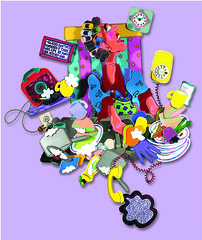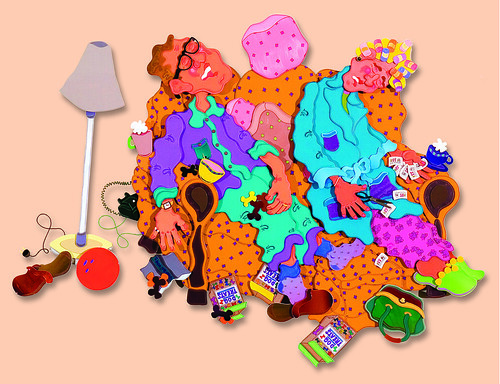‘Stories from the Kitchen Sink’ Installation Challenges Conventions
Stories from the Kitchen Sink: Comic Multimedia Installation Examines American Domesticity
 From now through Sunday, June 21, 2015, the Community Gallery at the Michele and Donald D’Amour Museum of Fine Arts in Springfield, MA, will host a special, site-specific installation by Sheffield, Massachusetts-based artist Ricky Bernstein. The installation, titled Stories from the Kitchen Sink: Bob and Phyllis Learn New Tricks, contains oversized collage-style graphics that depict stereotypically-American domestic scenes. These “still life sit-com” images are both humorous and critical, drawing attention to past and present ideas about modern life, multi-tasking, and gender roles.
From now through Sunday, June 21, 2015, the Community Gallery at the Michele and Donald D’Amour Museum of Fine Arts in Springfield, MA, will host a special, site-specific installation by Sheffield, Massachusetts-based artist Ricky Bernstein. The installation, titled Stories from the Kitchen Sink: Bob and Phyllis Learn New Tricks, contains oversized collage-style graphics that depict stereotypically-American domestic scenes. These “still life sit-com” images are both humorous and critical, drawing attention to past and present ideas about modern life, multi-tasking, and gender roles.
Younger viewers will be particularly interested in these energetic, colorful, stylized representations of American families, and students interested in Pop Art and contemporary art will be able to draw connections between Bernstein and other artists who used graphic, comic imagery, while parents and adults will appreciate the gently satirical sentiments and questions that Bernstein’s installation poses.
Installation art is different than traditional art exhibitions because installations do not necessarily follow the “rules.” Ask your kids to about the last time your family visited a museum or gallery. Where was the art displayed? Was it arranged in an organized, even way along a series of walls? Was the art all hung at the same level on the wall? Many art exhibitions and displays follow a formula that has been developed over many years and is designed to provide an optimal art-viewing experience. For example, hanging each piece of art so that the center of each work is at the same level – the majority of visitors’ projected “eye level,” or painting the walls of the gallery a color that either fades into the background or that highlights the colors and textures in the artworks themselves. Installation art, however, utilizes the full exhibition space, not just the walls, and is often site-specific, meaning that the art on display was created specifically to be displayed in that particular place. If Bernstein’s Stories appear anywhere else after the D’Amour Museum, they will not necessarily be displayed in the same way, and the change in their arrangement may cause viewers to interpret them in a different way.

Installations – sometimes called “interventions” – can also be site-specific due to the artist’s intended message. Have you heard about A Subtlety by Kara Walker? It is a gigantic sculpture made of sugar that was created expressly to be exhibited in the old Domino Sugar Factory in Brooklyn, NY. Walker created the sculpture (which is reminiscent of both a sphinx and of historically derogatory imagery of Black and African-American women) to serve as an homage to the enslaved peoples who labored in sugar cane fields and the sugar industry for centuries. This is a particularly effective intervention at the Domino Sugar Factory, now defunct and awaiting demolition, because it signifies the perseverance of the people who were oppressed by structures like the Domino Sugar Refining Plant that perpetuated a horrifying culture of back-breaking slave labor and the dehumanization and objectification of non-white people. Walker’s intervention has raised awareness about the violent history of the sugar industry in the United States and has ensured that very few people will remember the Domino Sugar Factory in the future without also remembering her monument to the many people who were hurt by it. In essence, her intervention literally intervened in the perpetuation of an inaccurate history of the site. Had her sculpture been displayed anywhere else – for example, a museum gallery – it would not have made the same impact or had the same long-term effects. (Please note: This is just an example of how installation art is a powerful medium: there is much more to read, and to be said, about “A Subtlety” elsewhere.)
Can you think of any reason why Bernstein’s Stories are particularly relevant to the Community Gallery at the D’Amour Museum – or the museum in general? What might his (humanely) cynical take on familiar domestic narratives imply about the museum? How might his installation change the way that the museum is viewed in the future? How might his installation change the way that other art in the museum is viewed?
Bring your curiosity this summer to the Michele and Donald D’Amour Museum of Fine Arts. Ask questions. Explore art with your family and take a journey into the world art with your family. Open 10am-5pm Monday-Saturday, 11am-5pm Sundays. Admission is $18 for adults, $12 for seniors and college students, and $9.50 for children ages 3-17. The fee provides admission to all four Springfield Museums. Admission is free for members and Springfield residents with proof of address. 413-263-6800.
Image Credits:
Kitchen Dreams, 2005, Ricky Bernstein, glass and mixed media
Dog Dreams, 2006/2012. Ricky Bernstein, glass and mixed media
 Hilltown Families
Hilltown Families 




























